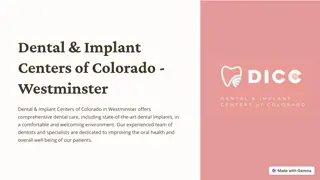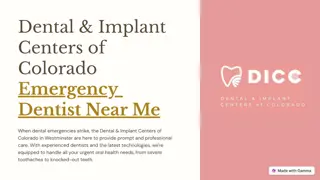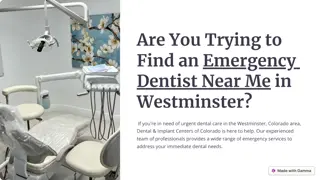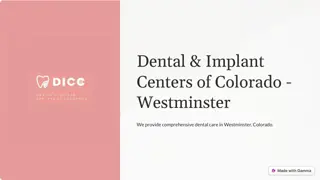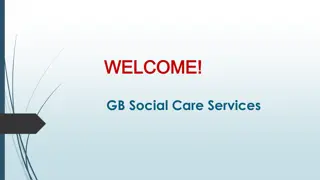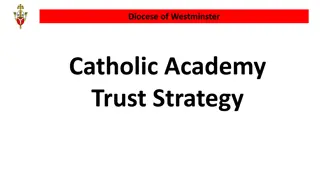Understanding Youth Statistics for Westminster & Kensington-Chelsea
Explore key statistics on youth crime, demographics, and deprivation in Westminster and Kensington-Chelsea through evidence packs and reports. Learn about the challenges faced by young Londoners and initiatives like the Young Londoners Fund aimed at supporting them. Gain insights into population projections, age demographics, diversity, and levels of deprivation in these areas.
Download Presentation

Please find below an Image/Link to download the presentation.
The content on the website is provided AS IS for your information and personal use only. It may not be sold, licensed, or shared on other websites without obtaining consent from the author. Download presentation by click this link. If you encounter any issues during the download, it is possible that the publisher has removed the file from their server.
E N D
Presentation Transcript
Young Londoners Fund Westminster & Kensington & Chelsea Evidence pack
Aim High Harm in last 12 months Knife crime 31 (4%) Gun crime 11(11%) Domestic Abuse 150 (8%) Racist hate crime 32 (3%) Sexual abuse 27 (2%) To provide an overview of key statistics and data relating to young people in Westminster to provide an evidence base for community and voluntary sector organisations to bid for funding. The Mayor s 45 million Young Londoners Fund is helping children and young people to fulfil their potential , particularly those at risk of getting caught up in crime. Provide aspirational and positive activities to help support young people to make positive choices and reach their potential. Give new options to children and young people most at risk of taking the wrong path and stop them getting involved in violence and criminal activity. Improve coordination and capacity of London's youth offer so more children and young people can access services. High Harm in last 12 months Knife crime 185 (21%) Gun crime 16(11%) Domestic Abuse 212 (11%) Racist hate crime 269 (21%) Sexual abuse 251 (20%) Westminster Annual Public Health report 2017-18 found crime and safety was one of the primary concerns raised by young people. In particular the impact of gang culture and associated peer pressure on health and wellbeing was clearly recognised. 11% increase last 12 months, increase from 47 to 55 offences per day. Theft person and other theft account for most of the increase.
Population In 2019 Westminster estimated to have a population of 248,812. 12% of the population are aged 10 -21. This table shows the ward breakdown of the population aged 10-21. Those highlighted in pink are the top 10%, i.e. Church Street and Knightsbridge and Belgravia. Over the next 5 years population in the borough is expected to increase by 3% whilst the 10 -21 age group by 8%. Source: https://data.london.gov.uk/dataset/projections
Population In 2019 Kensington and Chelsea estimated to have a population of 159,556. 11% of the population are aged 10 -21. This table shows the ward breakdown of the population aged 10-21. Those highlighted in pink are the top 10%, i.e. Courtfield. Over the next 5 years population in the borough is expected to increase by 4% whilst the 10 -21 age group by 7%. Source: https://data.london.gov.uk/dataset/projections
Deprivation Westminster s local areas are among the most and least deprived in London according to the 2015 Index of Multiple Deprivation. This index articulates deprivation of households as an accumulation of seven dimensions, Living Environment, Barriers to Housing & Services, Crime and Disorder, Income, Employment, Health & Diversity and Education and Skills training. Westminster is within the 30 -40% most deprived borough s in the UK for the average overall rank. Church Street ward is in the top 10% most deprived wards in the UK and pockets of other wards are too.
Deprivation RBKC The Borough contains some of the most deprived communities in the country with 11 of the 103 Lower Super Output Areas in the Borough experiencing deprivations in the bottom ten per cent of any community in England and Wales. multiple The Indices of Multiple Deprivation (IMD) and Income Deprivation affecting Children (IDACI) poverty scales from 2015 identify Golborne and Dalgarno as having the highest level of deprivation in the Borough. As this analysis is down to a more granular level (Lower Super Output Areas) it identifies a small deprivation in the Brompton Hans Town and Chelsea. pocket of high
Income deprivation affecting children 2015 28.7 is the score for Westminster which is higher than the London average of 24.1. This map shows how it is concentrated in the wards of Church Street Queen s Park Harrow Road Westbourne The income Deprivation Affecting Children Index is the proportion of all children aged 0 to 15 living in income deprived families. Income deprived families are defined as families that either receive Income Support or income based Jobseekers Allowance or income based Employment and Support Allowance or Pension Credit or families not in receipt of these benefits but in receipt of Working Tax Credit or Child Tax Credit with an equivalised income (excluding housing benefit) below 60% of the national median before housing costs.
Income deprivation affecting children 2015 In RBKC the levels of deprivation are more stark when focusing solely on deprivation affecting children, particularly Golborne, Notting Dale, Hans Town and Chelsea Riverside (Worlds End). The proportion of secondary school pupils in Kensington and Chelsea entitled to free school meals is 16.4%, which is significantly above the national average of 12.4%, and slightly above the London average of 15.9%.
Vulnerable localities profile WARD VLP 2016 VLP 2017 VLP 2018 Change Vulnerability to crime and antisocial behaviour is becoming increasingly concentrated within certain places and among certain individuals. The MOPAC Vulnerable Localities Profile (VLP) has been created using London specific data related to crime, deprivation and population. It is used to identify priority neighbourhoods that are places experiencing high levels of crime in residential areas, alongside problems of deprivation and demographic factors that influence the area s poor sense of community cohesion. Church Street 126.5 129.0 119.3 -9.7 St James's 95.0 111.0 113.4 2.4 Harrow Road 100.7 100.3 103.6 3.3 Queen's Park 125.0 119.3 100.7 -18.6 Westbourne 95.8 100.4 96.4 -4.0 Churchill 102.2 97.4 92.8 -4.6 Knightsbridge and Belgravia 82.5 87.0 87.9 0.9 Bayswater 98.7 88.0 83.8 -4.2 Vincent Square 78.5 83.0 83.7 0.7 Hyde Park 76.7 79.4 83.2 3.8 100 is the average score across London. Church Street remains the highest vulnerable ward in Westminster. West End 79.0 82.4 82.6 0.2 Bryanston and Dorset Square 83.6 93.8 82.3 -11.5 Tachbrook 70.3 63.4 82.1 18.7 Young people brought up in deprived neighbourhoods by fragmented families are more susceptible to members of commodity based Organised Crime Groups or street gangs looking to recruit. Initially these young people can become involved in anti- social behaviour and petty crime before progressing into more significant criminality. Lancaster Gate 92.5 85.5 81.7 -3.8 Warwick 84.1 75.7 81.1 5.4 Little Venice 78.2 71.3 79.8 8.5 Maida Vale 92.0 75.5 74.9 -0.6 Marylebone High Street 71.6 65.4 70.8 5.4 Regent's Park 63.3 65.8 68.2 2.4 Abbey Road 70.2 82.4 67.5 -14.9 Source: MOPAC London Landscape
Vulnerable localities profile RBKC Ward Name VLP, 2018 100 is the average score across London and there are five wards in RBKC that fall above this and all of them are in North Kensington Neighbourhood. Golborne Notting Dale Colville St. Helen's Dalgarno Earl's Court Chelsea Riverside Norland Pembridge Holland Courtfield Queen's Gate Royal Hospital Redcliffe 133.5 120.8 119.9 114.3 109.5 97.8 97.3 95.0 92.9 90.2 88.7 85.5 76.3 73.8 Brompton & Hans Town 71.1 Abingdon Campden Stanley 63.7 62.0 59.0
Troubled Families % of all troubled families % of families meeting crime criteria Troubled families are identified based on whether they have two or more complex needs, which fall within 6 criteria; crime and anti-social behaviour, poor school attendance, children in need, worklessness or financial insecurity, domestic violence and parents or children which suffer from health problems. The table to the left shows the percentage of families by ward who meet the crime criteria. The table below breaks this data down further to look at the top three wards, where families were identified as meeting the Troubled Families criteria from the data sources listed. Ward Queen's Park Church Street Westbourne Harrow Road Churchill Maida Vale St James's Little Venice Vincent Square Abbey Road Regent's Park Warwick Tachbrook Bryantston and Dorset Square Hyde Park Lancaster Gate Bayswater West End Marylebone High Street Knightsbridge and Belgravia 13.0 14.0 12.8 9.2 7.8 5.9 3.1 4.3 4.2 2.2 3.2 2.7 3.1 2.1 3.0 2.9 2.6 1.9 1.2 0.8 14.7 13.2 13.2 9.6 8.0 5.2 3.9 3.6 3.3 3.3 3.0 2.8 2.7 2.5 2.4 2.4 2.1 2.1 0.9 0.9 Dataset Ward 1 Queen's Park Church Street Harrow Road Church Street Queen's Park Westbourne Church Street Queen's Park Westbourne Queen's Park Church Street Westbourne Westbourne Queen's Park Church Street Queen's Park Church Street Westbourne Queen's Park Church Street Westbourne Queen's Park Church Street Westbourne Queen's Park Church Street Westbourne Westbourne Queen's Park Harrow Road Ward 2 Ward 3 EarlyHelp Child in Need Department of work and pension Attendance Special Education Needs YOT Exclusions Domestic Violence Missing Children Looked after Children Not in employment education or training Queen's Park Westbourne Child Sexual Exploitation* EarlyYears Church Street Vincent Square Queen's Park Queen's Park Westbourne Church Street Westbourne






